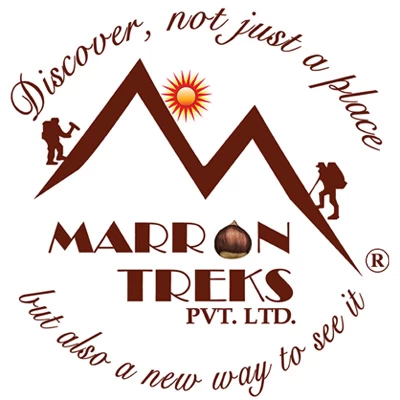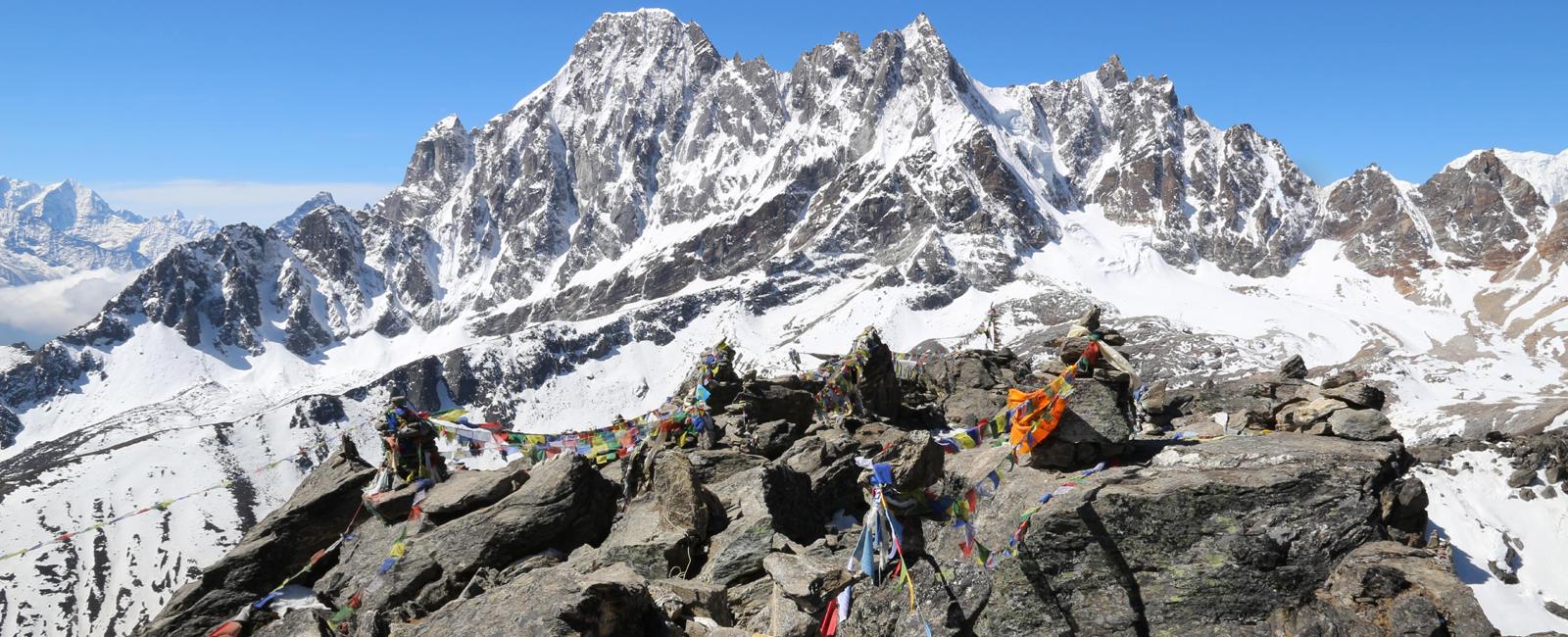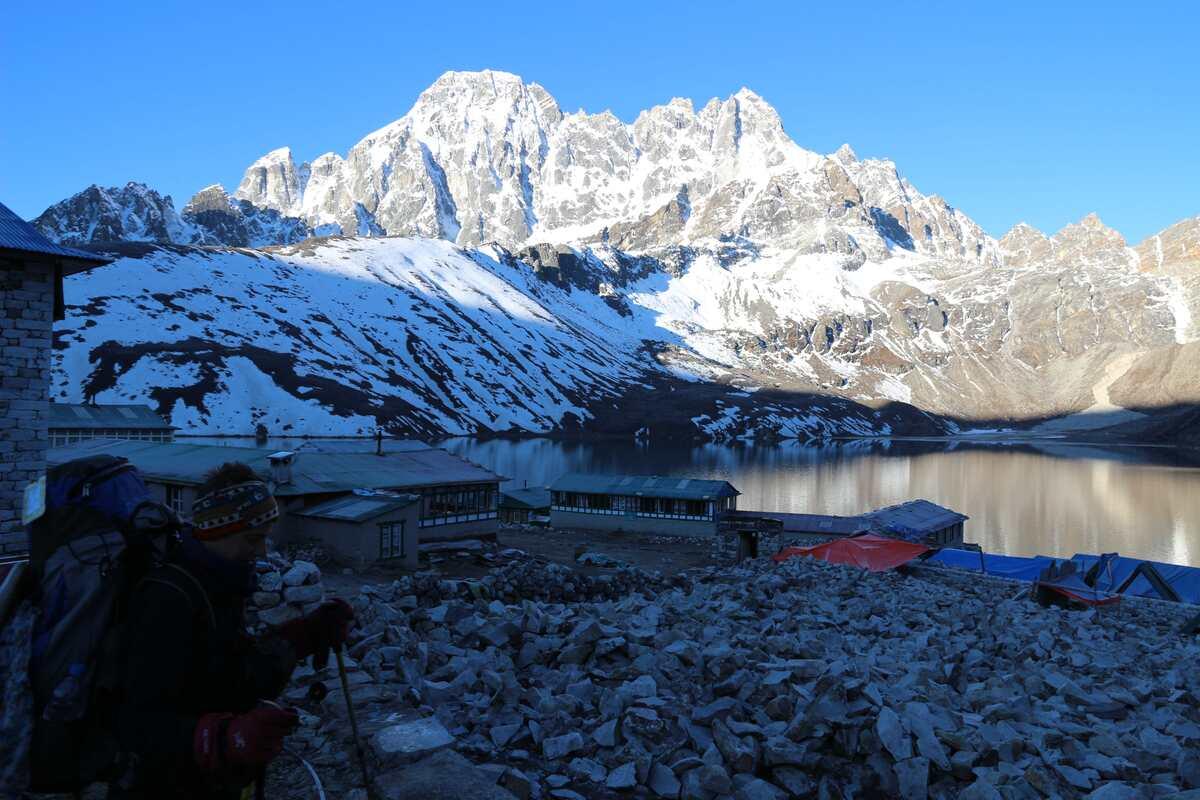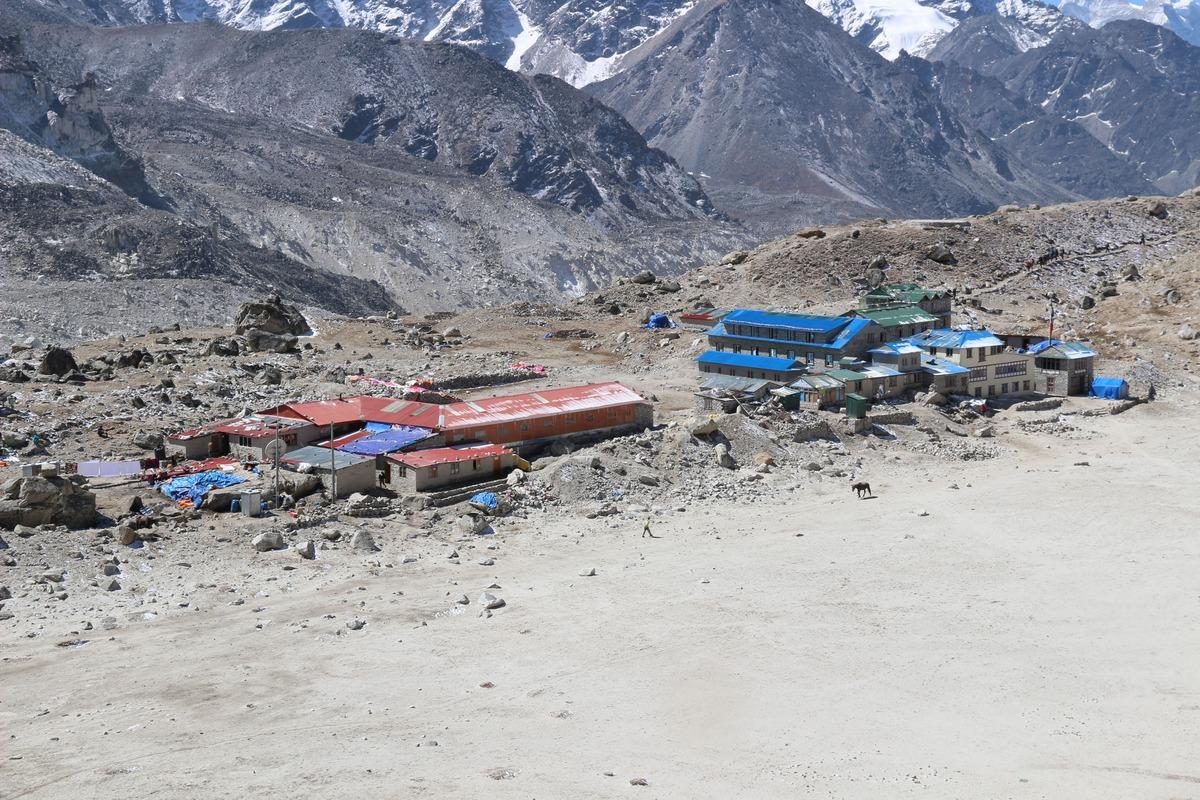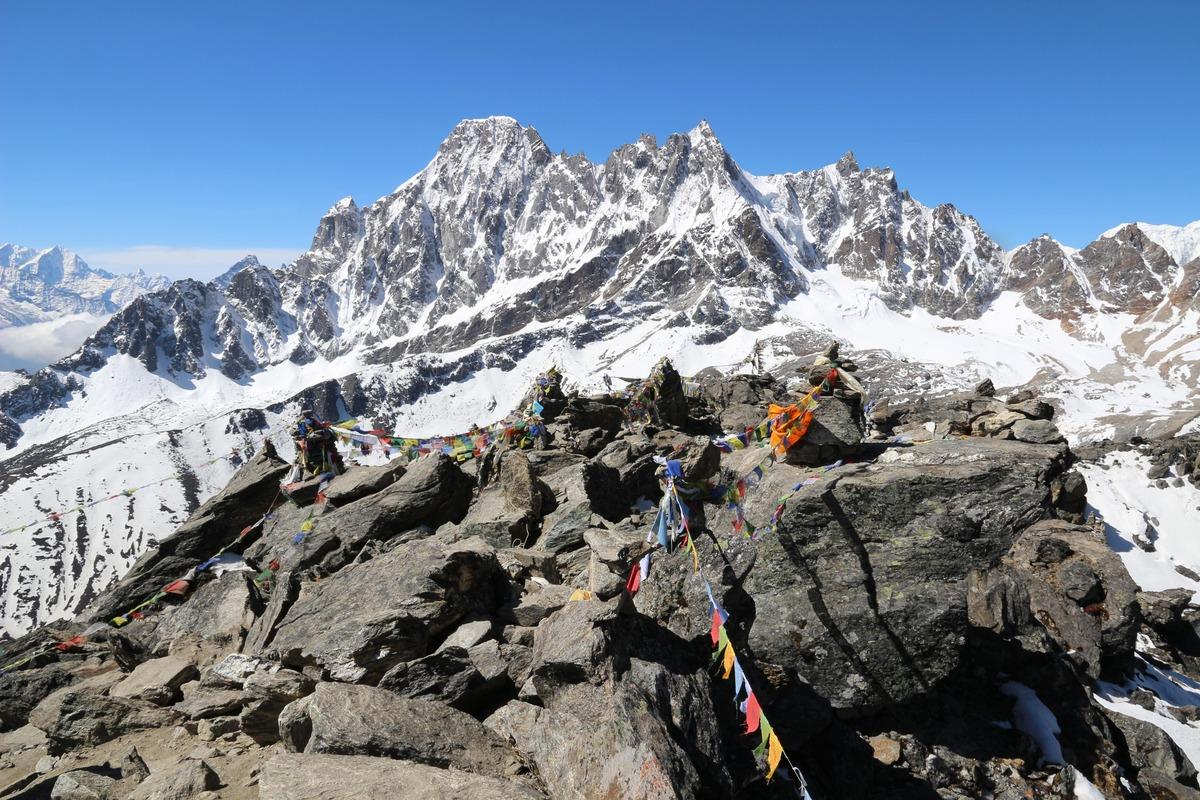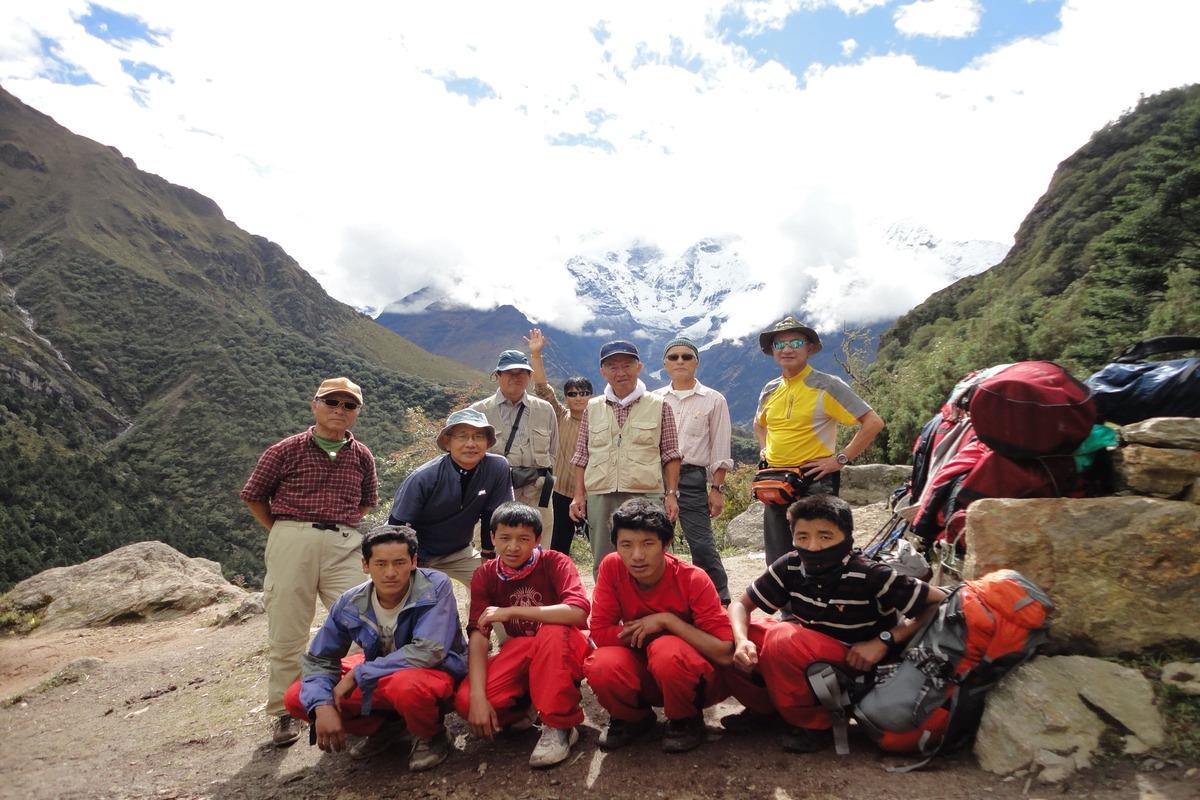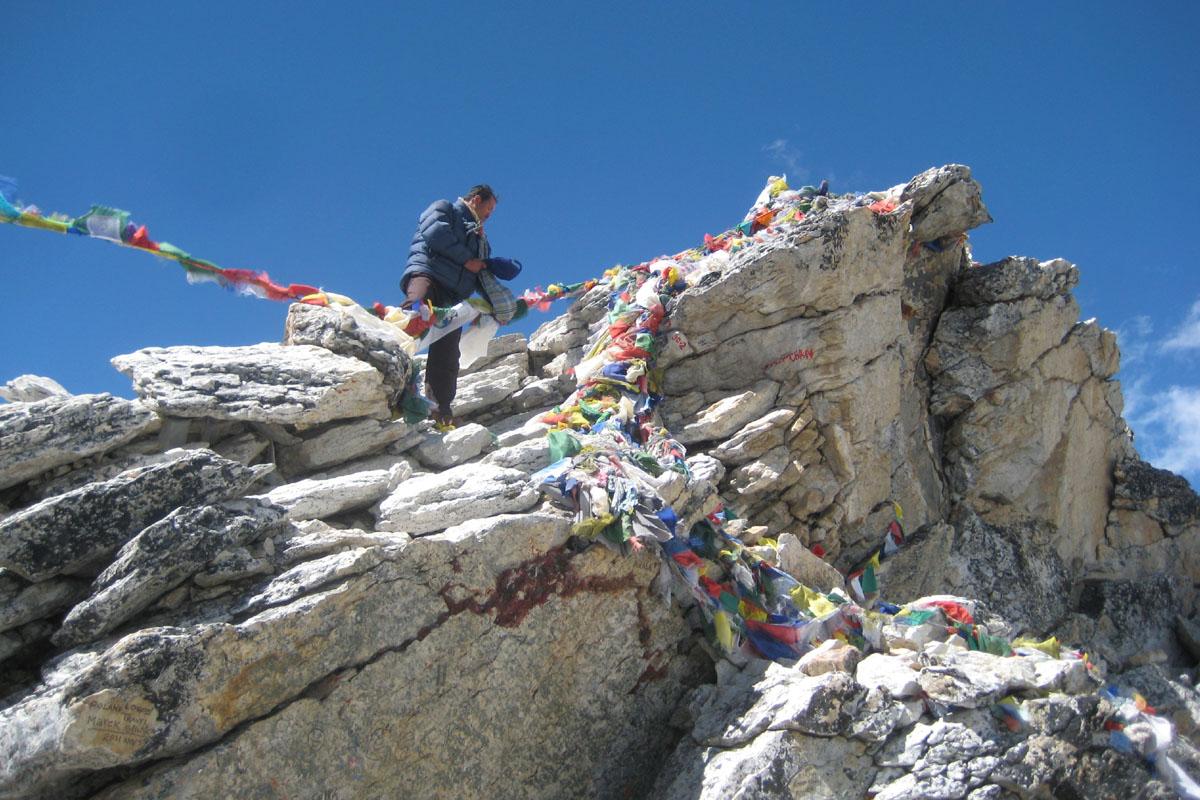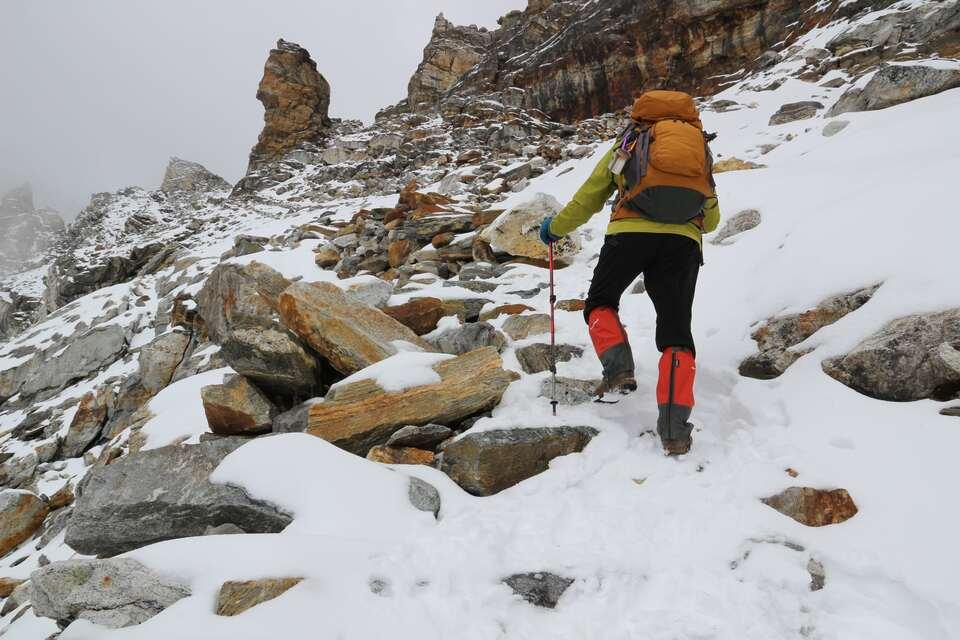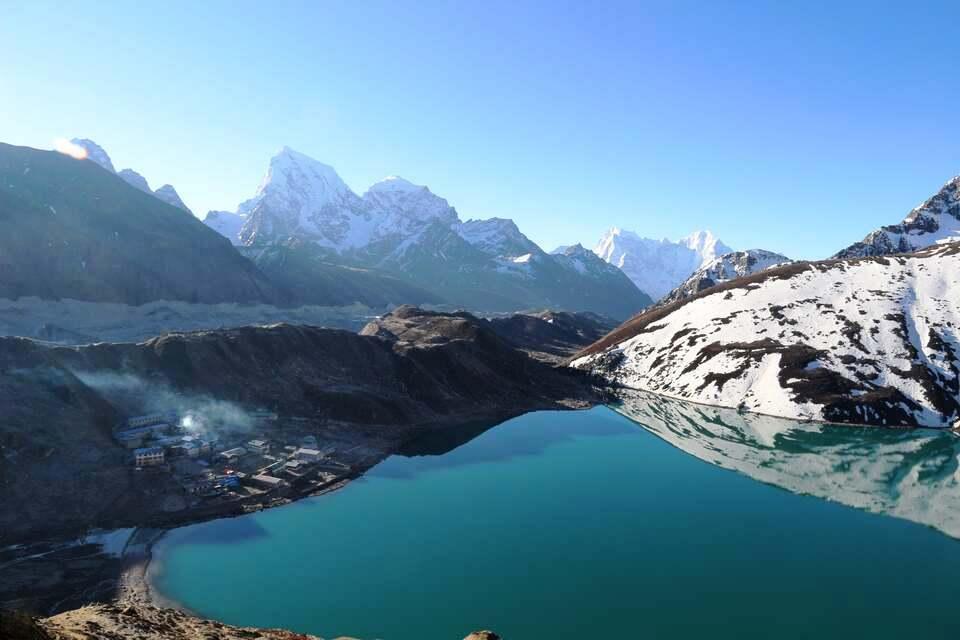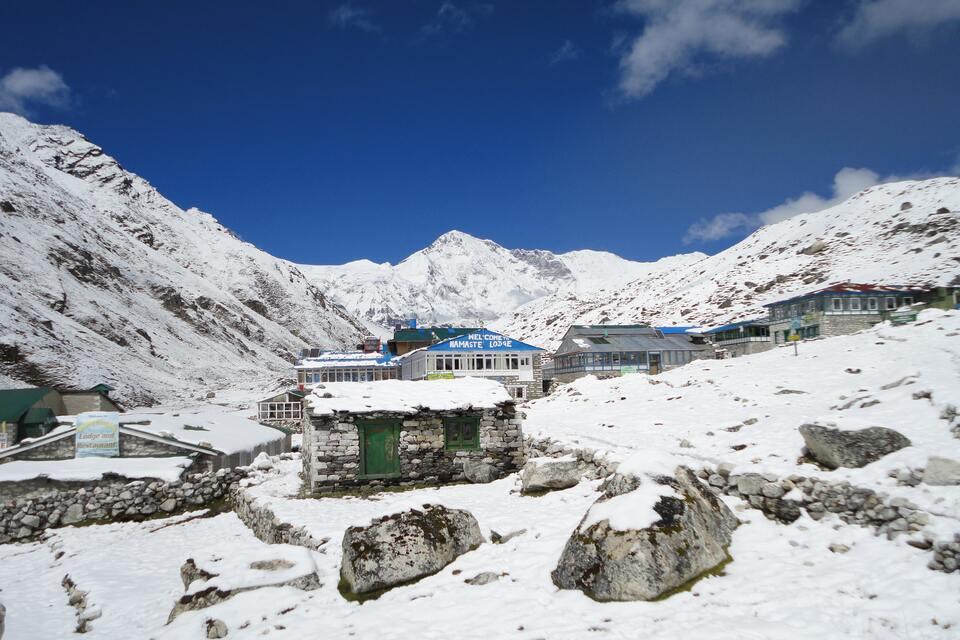Gokyo Lake Renjo La Pass Trek
Trip at a Glance
Gokyo Lake Renjo La Pass Trek is one of the challenging and rewarding treks in the Everest region. The trek involves crossing over one of the high passes of Khumbu, the Renjo La Pass and trekking in the beautiful Gokyo Valley where the dazzling turquoise Gokyo Lake is located. During the trekking route, one also gets to witness the world’s highest peaks including Mt. Everest during the trekking route.
Gokyo Lake Renjo La Pass Trek is a bit off the beaten path if compared to the popular Everest Base Camp trek. The trek begins after a scenic flight to Lukla from Kathmandu and the trek begins to Phakding and eventually to Namche Bazaar. You will then take a different route to the stunning Gokyo Valley and cross over Renjo La Pass.
In Gokyo, one can explore the beauty of Gokyo Lake which is the world's highest freshwater lake system. You can climb up to the popular Himalayan viewpoint Gokyo-Ri at 5,360 meters which provides a spectacular Himalayan view of the world’s highest peaks including Mt. Everest. The trek then proceeds with a crossing over Rinjo La pass at 5,340 meters which commands another stunning Himalayan view.
Gokyo Lake Renjo La Pass Trek is a rewarding trek that takes you to some of the most spectacular landscapes in the Everest region and is ideal for any adventurous trekkers who love to explore the Himalayas.
Gokyo Lake Renjo La Pass Trek Highlights
- Take a trip to one of the high passes Renjo la pass at 5,340 meters
- Trek via challenging trails in the Khumbu region
- Explore Sagarmatha National Park, the UNESCO World Heritage Site
- View the sunrise & spectacular Himalaya panorama by ascending Gokyo Ri (5360m)
- Explore the Sherpa people's ancestral home and charming communities
- View the stunning scenery of snow-capped mountains such as Everest, Cho Oyu, etc.
Itinerary
Day 01: Arrival in Kathmandu
Day 02: Fly from Kathmandu to Lukla (2840m/40min) & Trek from Lukla to Phakding (2610 m/3-4 hrs)
Day 03: Trek from Phakding to Namche Bazaar (3440m/5-6 hrs)
Day 04: Rest day in Namche Bazaar for Acclimatization & Hike to Hotel Everest View (3880m/3-4 hrs)
Day 05: Trek Namche to Dole (4038m/5-6 hrs)
Day 06: Trek from Dole to Machhermo (4470m/4-5 hrs)
Day 07: Trek from Machhermo to Gokyo Lake (4750m/4 -5 hrs)
Day 08: Hike to Gokyo RI (5357m/4-5 hrs)
Day 09: Trek from Gokyo to Lunden (4300m) via crossing Renjo la pass (5340m/6-7 hrs)
Day 10: Trek from Lunden to Thame (3800m/4-5 hrs)
Day 11: Trek from Thame to Namche Bazaar (3440m/4-5 hrs)
Day 12: Trek from Namche to Lukla (2840m/6-7 hrs)
Day 13: Flight from Lukla to Kathmandu (1400m/40min)
Day 14: Final Departure
Arrive in Kathmandu and one of our representatives will receive you and then transfer to your hotel in Kathmandu. The rest of the time is free to explore the city where your hotel is located which is usually at Thamel – the popular tourist hub in Kathmandu where every needs and facilities for the tourist are located like hotels, pubs, restaurants, departmental stores, trek gear shops etc. Or you can simply rest at your hotel if you are jet lagged and get ready for an amazing Himalayan trek.
Wake up early in the morning and drive to the domestic section of the airport in Kathmandu for a flight to Lukla. After checking the weather it’s flight from Kathmandu to Lukla at Tenzing Hillary Airport. You will have a packed breakfast from the hotel which can be eaten while waiting for the plane at Kathmandu airport.
After 40-45 minutes flight from Kathmandu you will finally land at Lukla then being your trek to Phakding –a small village in Khumbu region. Lukla is also the place where your porters will be waiting for you. The trail goes through a green path crossing several villages like Chauri Kharka and Ghat then finally reaches Phakding for an overnight stay
Note: Flights from Tribhuvan International Airport (TIA) in Kathmandu to Lukla and vice versa may be rerouted to Manthali during the peak trekking seasons of March, April, May, September, October, and November due to increased air traffic congestion. Manthali is 5 hours drive from Kathmandu and we need to start at 12.30am for Kathmandu/Manthali drive to catch the flight to Lukla from Manthali. During December, January, February, June, July, or August, you will experience a direct flight from Kathmandu to Lukla and vice versa.
After breakfast, the trek begins with the trail going through forests, traditional villages with plowed fields, and yak pastures then reaches the entrance of Sagarmatha National Park from where Mt. Thamserku can be spotted.
After completing permit formalities and having lunch you will climb up to Namche Bazaar. Namche Bazaar is the gateway to the Everest region and the biggest Sherpa town in the Khumbu region where many hotels, luxury resorts, restaurants, pubs, trek shops etc are located. You name it, they have it at Namche and if you forget to shop for any trek gear in Kathmandu, Namche is the last point to do so but the price may differ.
Today is the rest day at Namche Bazaar for acclimatization and to cope with the rising elevation. You can go for a side excursion to Hotel Everest View (3880m) which is considered the hotel located at the highest point on earth. From it’s balcony you can have the first glimpse of Mt. Everest and other world’s highest peaks sipping tea/coffee. Then it’s back to your hotel in Namche Bazaar. In the evening, you can explore around Namche, talk with the locals, meeting many other trekkers and mountaineers from around the world.
From Namche Bazaar, the trail ascends gradually with some ups and downs. You’ll pass through several small settlements, enjoying stunning views of Mount Everest, Lhotse, and Ama Dablam along the way. After a few hours of trekking, you’ll reach Kyangjuma, a small village with teahouses and lodges.
Leaving Kyangjuma, you’ll head to Mong La. The trail involves some steep uphill sections, but the panoramic views of mountains like Khumbila and Thamserku make it worthwhile. Mong La is an excellent place to take a break and have some refreshments before continuing your trek.
After resting in Mong La, you’ll descend down towards the Dudh Koshi River and then climb back up through rhododendron and pine forests to reach Phortse Tenga, a small settlement with lodges and tea houses. From Phortse Tenga, the trail leads you through lush forests and over suspension bridges. You’ll pass through some beautiful waterfalls and eventually start climbing up to Dole, which lies above the tree line. As you ascend, the vegetation becomes sparse, and the landscape changes drastically. Dole offers stunning views of mountains like Kantega, Cho Oyu, and Thamserku.
The trail continues to climb gradually through yak pastures and alpine landscapes. You’ll come across Mani stones (engraved with Buddhist prayers) and chortens along the way. Luza is a small settlement with teahouses and lodges where you can take a break and enjoy the serene surroundings.
From Luza, the trail leads you along the Dudh Koshi River and up towards Machhermo. The trek involves a steady climb, and you’ll cross some small streams and enjoy views of the snow-capped peaks around you. As you approach Machhermo, the valley widens, and you’ll be surrounded by stunning mountain vistas.
Once you reach Machhermo, you can explore the village and its surroundings. Machhermo is a beautiful settlement with a few lodges, providing a perfect place to rest and acclimatize further. It’s essential to stay hydrated and take it easy to adjust to the high altitude.
The trek begins with a gradual ascent from Machhermo to Pangka. You’ll pass through yak pastures and enjoy breathtaking views of Cho Oyu, the sixth-highest mountain in the world. The trail may involve some ups and downs, but it’s relatively moderate compared to some other sections of the Everest region trek.
From Pangka, the trail continues to climb towards the Gokyo Valley. You’ll reach the first of the six Gokyo Lakes, which is a mesmerizing sight with its turquoise waters and the backdrop of snow-capped peaks. The trail then leads to the main village of Gokyo, located next to the third Gokyo Lake. Gokyo is a picturesque village with lodges and teahouses, surrounded by the stunning Himalayan scenery. Once you arrive in Gokyo, you can take some time to explore the village and its surroundings.
The hike to Gokyo Ri starts from the village of Gokyo. It’s a challenging ascent that involves walking on rocky terrain and some steep sections. The hike typically takes around 2 to 3 hours to reach the summit. However, the duration can vary depending on your fitness level and the weather conditions.
Once you reach the top of Gokyo Ri, you’ll be rewarded with a jaw-dropping 360-degree panorama of the surrounding mountains and lakes. The view includes Mount Everest (8848m), Lhotse (8516m), Makalu (8481m), Cho Oyu (8201m), and many other peaks. You’ll also have a stunning view of the Gokyo Lakes below, which are a series of glacial lakes that add to the beauty of the landscape.
After spending some time soaking in the mesmerizing views from the summit of Gokyo Ri, you’ll descend back to Gokyo Village. The descent usually takes around 1.5 to 2 hours.
The trek starts from Gokyo Village, and you’ll gradually ascend towards the Renjo La pass. The trail takes you through rocky terrain and might involve some steep sections. As you ascend, the views of the Gokyo Lakes and surrounding peaks become more impressive. You’ll reach the base camp of Renjo La, where you’ll spend the night before crossing the pass the next day.
Crossing Renjo La pass is the highlight of this trek. It’s a challenging ascent to the pass, and you’ll need to start early in the morning to ensure favorable weather conditions. The climb to the top of the pass rewards you with breathtaking panoramic views of Mount Everest, Lhotse, Makalu, and other peaks of the Everest region. After enjoying the view and taking some well-deserved rest, you’ll begin the descent to Lunden. The trail descends steeply, and you’ll pass through a beautiful valley with yak pastures and traditional Sherpa settlements. The trek from Renjo La pass to Lunden usually takes around 6 to 7 hours.
Lunden is a picturesque village with teahouses and lodges, providing a comfortable place to rest after a challenging day of trekking. The serene atmosphere and the warmth of the local Sherpa hospitality make Lunden a perfect place to relax and reflect on your adventure.
The trail descends through a beautiful valley with lush vegetation. You’ll pass through several small Sherpa settlements and enjoy views of the surrounding mountains. After a couple of hours of trekking, you’ll reach Marulung, where you can take a short break.
From Marulung, the trail continues along the Bhote Koshi River and takes you through rhododendron forests and traditional Sherpa villages. Thame is a significant village in the region, and it’s renowned for being the hometown of Tenzing Norgay, one of the first climbers to summit Mount Everest. The Thame Monastery is one of the main attractions of the village and holds religious and cultural significance.
The trek from Lunden to Thame typically takes around 4 to 5 hours, depending on your walking pace and the weather conditions. It’s a relatively moderate trek with some gradual descents, making it an enjoyable journey through the scenic landscapes of the Everest region.
The trek starts from Thame, a historic Sherpa village with a beautiful monastery. From Thame, the trail descends gradually, passing through small settlements and crossing suspension bridges over the Bhote Koshi River. After about an hour of trekking, you’ll reach Thamo, a charming village with tea houses and lodges.
Leaving Thamo, the trail continues along the Dudh Koshi River. You’ll pass through rhododendron and pine forests, enjoying the natural beauty of the region. After approximately 3 to 4 hours of trekking, you’ll reach Namche Bazaar, the bustling trading hub and the largest settlement in the Everest region. Namche Bazaar offers various facilities, including accommodation, restaurants, shops, and internet access.
The trek from Thame to Namche Bazaar typically takes around 4 to 5 hours, depending on your walking pace and the weather conditions. It’s a moderately challenging trek with some gradual ascents and descents, providing ample opportunities to enjoy the scenic landscapes and the cultural aspects of the region.
As you make your way down from the breathtaking mountain views behind you, you will descend to Lukla. The journey takes you through Jorsale, Monjo, and Phakding, showcasing the lush forests and magnificent mountainous terrain that will keep you captivated throughout the trek. Make sure to savor the final moments of gazing at the massive peaks and cherish the end of your Everest hike.
In the evening, it’s time to celebrate the successful completion of your Himalayan adventure with your crew and teammates. Take this opportunity to express gratitude to everyone, especially the porters who tirelessly carried your belongings. A festive atmosphere will envelop the hiking crew as you join the porters and guides in singing, dancing, and enjoying local brews. Before the night ends, consider offering tips as a gesture of appreciation to your porter, guides, and assistant guides, as you bid farewell to most of the porters and assistant guides in Lukla.
Tonight, as you lay down to sleep, let the memories of Everest fill your dreams, knowing that you accomplished an incredible feat.
Bid farewell to the Everest region and the mountain, and take again the trans-Himalayan flight back to Kathmandu to Lukla. The Himalayas slowly fade from your plane window screen and finally land at the airport in Kathmandu. Then drive to a hotel in Kathmandu. The rest of the time is free to explore or simply rest at your hotel.
The trip concludes and our office representatives will take you to the international airport in Kathmandu to catch your onward flight to your next destination or fly back home. You need to be at least 3 hours prior to your flight time at the airport.
Thank you for visiting Nepal and we hope your Himalayan Holiday has come true. Have a safe flight back home!
If you plan to extend your holiday then other travel activities like jungle safari, rafting, mountain biking, bungee jumping etc are also up on the list.
What is included?
- Airport pick-up and drop services.
- Hotel accommodations in Kathmandu with breakfast.
- Kathmandu/Lukla/Kathmandu round airfare.
- All trekking accommodations with Breakfast/Lunch/Dinner at local lodges.
- Four seasonal sleeping bag & Duffel bag (to be returned after trip completion).
- A comprehensive medical kit (will be carried by the trekking guide).
- Experienced Government licensed English Speaking Guide & Porter (1 porter for two people) including their food, accommodation, salary & insurance.
- Permits for Everest National Park, Khumbu Municipality and TIMS (Trekkers' Information Management System).
- Farewell Dinner at Nepali Authentic Restaurant.
- All government and local taxes.
What is not included?
- International airfares.
- Nepal entry visa fee – Visa can be obtained upon your arrival at the Tribhuwan International Airport in Kathmandu. (USD30 for 15 days)
- Lunch & dinner in Kathmandu.
- Personal travel insurance.
- Emergency rescue evacuation (to be covered by the client's travel insurance).
- Excess baggage charges (luggage allowance for domestic airlines in Nepal is 15 kgs.)
- Bar bills, alcoholic drinks & beverages.
- Expenses of personal nature (phone calls, laundry, battery recharge, extra porters, bottle or boiled water, hot shower etc.)
- Cost incurred due to the addition of extra days or change in the itinerary due to bad weather, political turmoil or any other unforeseen contingencies.
- Tips to guide & porters (Tipping is expected).
Route Map
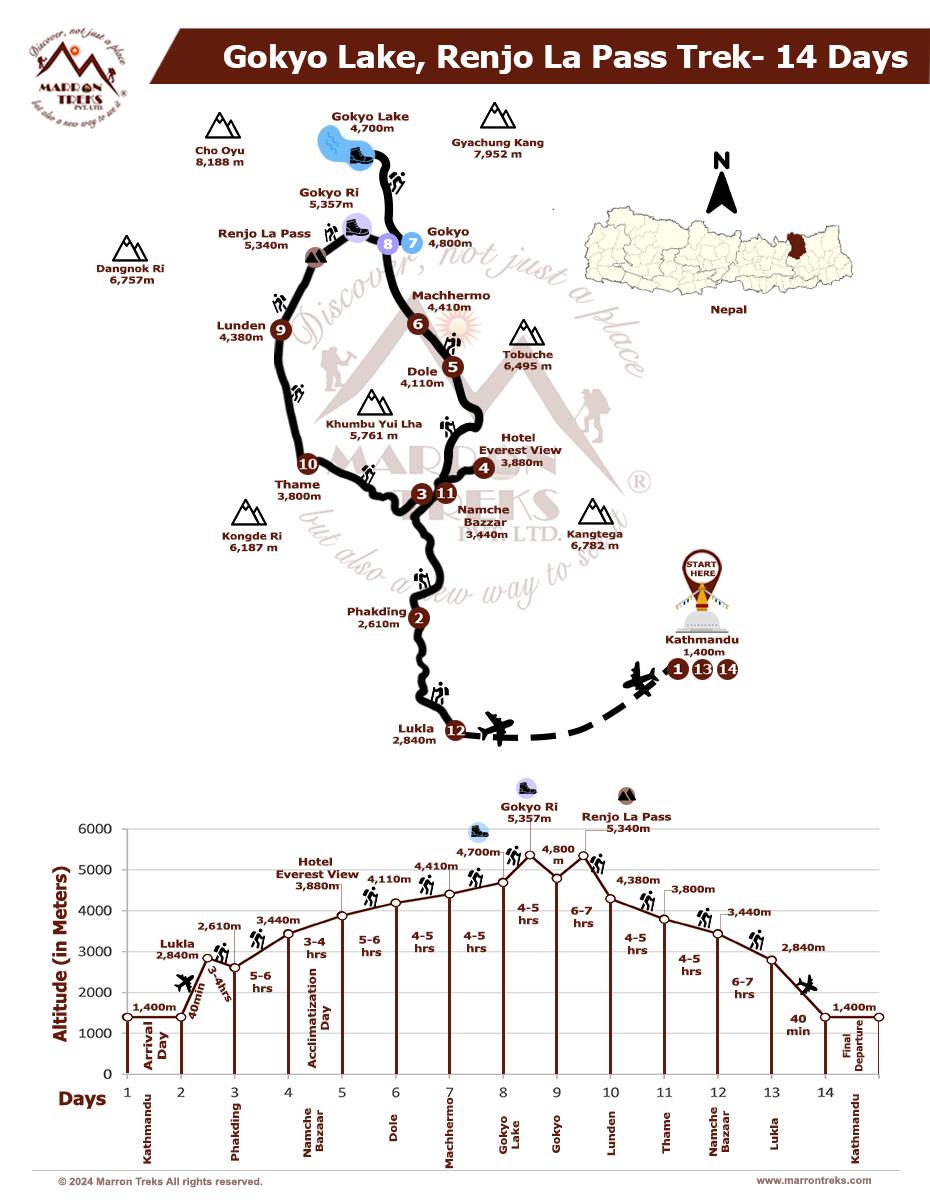
Trip Info
Accommodation
While you are in Kathmandu, we opt to accommodate you in 4- or 5-star hotels like Hotel Royal Singhi (4-star), Hotel Manaslu (4-star), Radisson (5-star), Yak & Yeti (5-star), or similar. During the trek, you will be accommodated in a local mountain lodge, better known as Tea House. These lodges and teahouses provide good services and are equipped with basic amenities. We will endeavor to provide you with the best accommodation available along the route so that you get a good night’s rest in a hygienic milieu.
Meals
We never compromise the quality of food or the health of the trekkers as well as the crew members. Generally, we opt for the fresh and nutritional local community food available. You could make your delicious pick from an array of traditional foods like Sweet potatoes, buckwheat barley, etc. This way, you could not only get a real sense of the local culture and life patterns but also contribute to promoting the locally available resources of organic food and beverages. Besides, a wide range of Continental, Chinese, Italian and Indian cuisines like Pizza, Spaghetti, French Fries, Soups, Breads, Masala curry, etc. are also available in the restaurants for your retreat.
Acclimatization
Altitude sickness is a serious risk while trekking in the Himalayas. It's important to acclimatize properly by spending a few days at lower altitudes before heading higher. By spending time at lower altitudes before pushing higher, your body has time to adjust. Our trekking packages have enough acclimatization days planned where you'll be spending a day or two at lower altitudes, allowing your body to adjust to the increasing altitude.
Electricity & drinking water
For an additional cost, you can use the electricity in all tea houses and lodges to recharge your batteries. The lodges have packaged mineral water for sale, or you can fill your bottle with boiling water. To make water drinkable, you can use water purification tablets too. But, due to hygienic issues, you should avoid drinking water from taps, rivers, or wells in trekking areas.
Communication
At lodges, restaurants, and hotels, Wi-Fi is available for an additional fee in the most popular trek regions, like Everest, and Annapurna. However, at high elevations, phone calls are the only means of connection. Our office in Kathmandu is in constant communication with your trek guide. In Kathmandu, you can purchase a local sim card for communication purposes. At high elevations, the mobile signal might not be as strong, though.
Luggage
Our porters are paired with one trekker for every two hikers, and one porter can safely carry 30 kg maximum weight. Therefore, we advise you to fill your duffle bag not more than 15 kg with your belongings. You may carry a small backpack with your valuables and informational documents. The things you are not taking along on the trek can be stored in a hotel in Kathmandu free of cost.
Typical Trek Day
Mostly your trek day starts with breakfast at 7-8 am, followed by a 3-4 hour morning trek. Lunch break is around an hour, then you continue trekking to your destination for the day. After reaching the teahouse lodge, you can relax, explore nearby areas, and enjoy dinner at 6-7 pm. Evenings involve socializing, a trek briefing, and leisure activities before bed.
Travel Insurance
It is advised that you arrange your travel insurance before leaving your homeland. The main thing is to make sure that your insurance covers you for both- medical and evacuation costs. Having travel insurance with you makes your trip secure and hassle-free.
Our Guides
Guides play a significant role during the trek. They are the ones who literally decipher the trekking codes for you so that you can actually connect with nature, culture and people along the way. We have helpful and dedicated trekking guides who are very well-versed in the culture, life patterns and every single detail pertaining to the trek region you are traveling in. Thus, in the company of our professional Sherpa guides, your trek becomes not only entertaining but also equally informative.
Porter and Staff Care
When it comes to high-altitude trekking, porters and staff members make up a pivot. Marron Treks ensures that all the porters and staff members going to high altitudes are provided with adequate clothing and equipment. All our field staff are covered by insurance.
